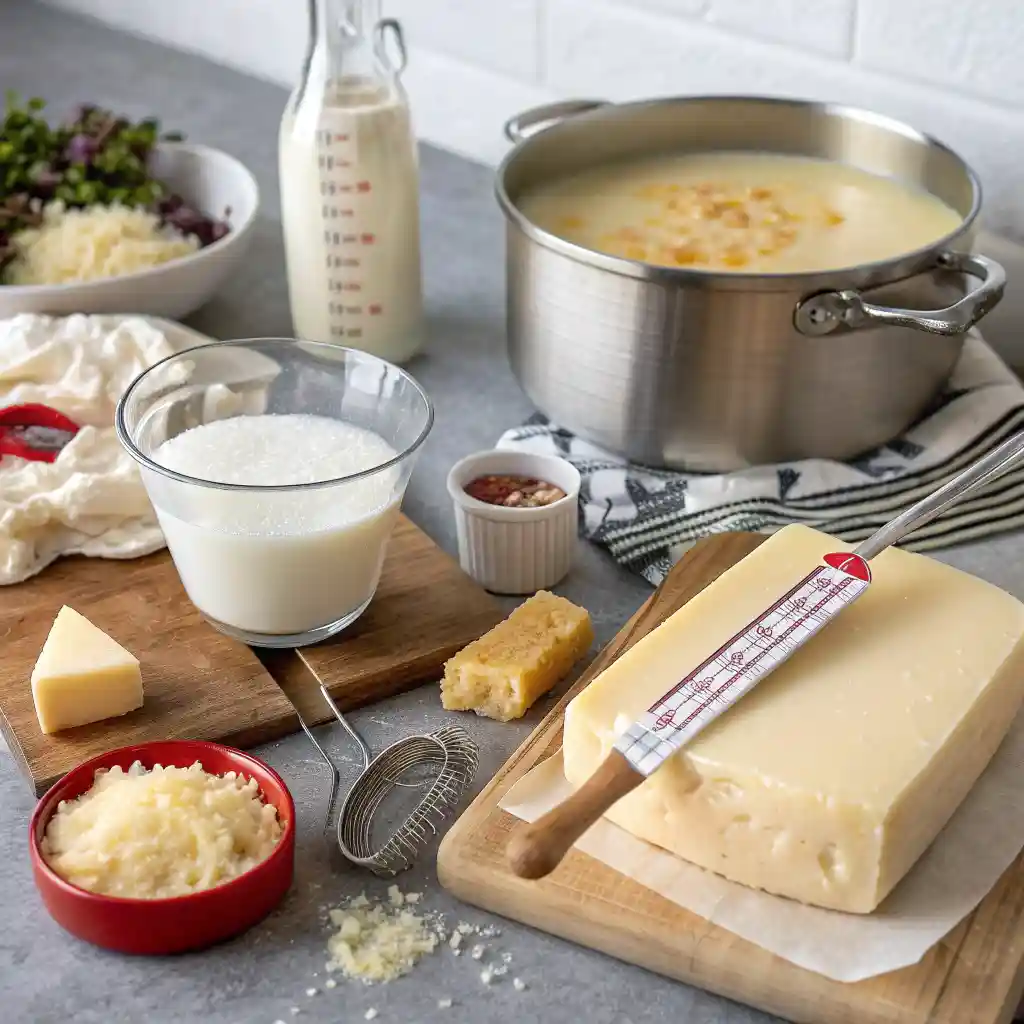Gruyère cheese, a celebrated variety of Swiss cheese, captivates cheese lovers with its complex flavour profile and rich history. Originating from the Alpine region, this semi-hard cheese made from cow’s milk has been a staple in Swiss cuisine for centuries, particularly in the town of Gruyère. The unique characteristics and traditional methods of production contribute to Gruyère’s status as one of the best cheeses in the world. In this article, we will explore what makes Gruyère cheese special, how it is made, its culinary uses, and where to find authentic varieties.
Table of Contents
Table of Contents
What is Gruyère Cheese?
How is Gruyère Cheese made?
Gruyère cheese is crafted through a meticulous process involving the use of raw cow’s milk and traditional cheesemaking techniques. The process begins with heating the milk and adding rennet to create curds. The curds are cut and gently stirred to separate the whey, then pressed to form the shape of the cheese. Afterward, the cheese is salted and placed in maturation caves, where it develops its distinctive flavours over time. This careful attention to detail ensures that each wheel of Gruyère cheese reflects the unique terroir of the Swiss Alps, making it a true representation of Alpine cheese craftsmanship.
Gruyère cheese is produced under stringent guidelines to preserve its authenticity and high quality. The cheesemakers, often referred to as artisans, ensure that the milk sourced is of the highest quality, typically from local farms. The cheese is then shaped into large wheels and aged for a minimum of five months, but some varieties may mature for up to 10 months or longer. During this time, the cheese develops its nutty and earthy flavours, which are characteristic of Gruyère. The entire process showcases the dedication of cheesemakers in preserving traditional methods while producing a beloved cheese that is enjoyed worldwide.
What distinguishes Gruyère from other cheeses?
What sets Gruyère cheese apart from other cheeses lies in its unique flavour and texture. Gruyère is known for its semi-hard consistency, making it versatile for various culinary applications. Unlike many Swiss cheeses, Gruyère has a rich, nutty flavour that is both earthy and slightly sweet, resulting from its aging process. This complex taste profile allows it to enhance a range of dishes, from fondues to gratins, and even French onion soup. Additionally, the AOP (Appellation d’Origine Protégée) designation protects Gruyère’s quality, ensuring that only cheese made in the designated region can be labeled as such, further distinguishing it from other varieties.
Furthermore, the production of Gruyère cheese involves specific techniques that contribute to its unique identity. The cheese is typically made in large wheels, which helps in achieving a consistent texture and flavour throughout. The aging process plays a crucial role, allowing the cheese to develop its characteristic aromas and depth of flavour. This attention to detail, combined with the natural resources and climate of the Alps, creates a product that is not only delicious but also embodies the rich heritage of Swiss cheesemaking. Gruyère’s distinction is celebrated by cheese lovers and culinary enthusiasts alike, making it an essential cheese in the world of cow’s milk cheese.
What is the history of Gruyère Cheese?
The history of Gruyère cheese dates back to the Middle Ages, around the 12th century, when it was first produced in the town of Gruyères in Switzerland. The cheese’s origins are deeply intertwined with the agricultural practices of the region, as local farmers began to make cheese from the abundant milk supplied by their cows. Over the centuries, Gruyère cheese became an integral part of Swiss culture and cuisine, cherished for its rich flavour and versatility. By the 19th century, Gruyère gained international recognition, leading to its export beyond Swiss borders, including to markets for French Gruyère.
As Gruyère cheese gained popularity, its production methods were refined, and the cheese began to be made in larger quantities. The establishment of the AOP designation in the 2000s further solidified its reputation, ensuring that only cheese produced in the region following traditional practices could bear the Gruyère name. This historical significance, along with its unique flavour and quality, has established Gruyère as not only a regional treasure but also a beloved cheese worldwide. The legacy of Gruyère continues to thrive, supported by dedicated cheesemakers who uphold its rich tradition and ensure its place in culinary history.

What are the characteristics of Gruyère Cheese?
What is the flavour profile of Gruyère Cheese?
The flavour profile of Gruyère cheese is a delightful combination of nutty, earthy, and slightly sweet notes, which develops intricately during its maturation process. As the cheese ages, these flavours become more pronounced, offering a complex tasting experience that can vary from one wheel to another. Fresh Gruyère offers a gentler flavour, whereas older versions reveal more intense and complex tastes. This versatility makes Gruyère cheese an excellent choice for various culinary applications, from melting in fondues to adding depth to a cheese board featuring Wisconsin cheese.
Gruyère’s distinct qualities come from its traditional production techniques and the high-grade raw cow’s milk used. The cheese is typically made in small batches by artisanal cheesemakers in the town of Gruyère, ensuring that every wheel reflects the distinct terroir of the Swiss Alps. The flavour can also be influenced by factors such as the cows’ diet, which often consists of fresh Alpine grass and wildflowers, imparting subtle floral notes to the cheese. This combination of natural elements and traditional cheesemaking techniques creates a flavour profile that is both memorable and versatile, appealing to cheese lovers everywhere who enjoy le Gruyère AOP.
How does the maturation process affect Gruyère Cheese?
Aging plays a crucial role in shaping Gruyère cheese’s distinctive traits and complex flavour. During this aging period, which typically lasts at least five months, the cheese undergoes significant changes. As it matures, the moisture content decreases, resulting in a firmer texture. Enzymatic reactions occur, breaking down proteins and fats, which enhances the cheese’s flavour complexity. The combination of these factors leads to the nutty and earthy notes that Gruyère is renowned for.
In addition, the conditions in which the cheese is aged are key to determining its final quality. Gruyère cheese is traditionally aged in cool, humid caves, where temperature and humidity are carefully controlled. This environment allows the cheese to develop a natural rind, which not only protects the interior but also contributes to its flavour. The maturation process can last for up to 10 months or more, with longer aging times producing cheese with a more intense taste and aroma. Consequently, the maturation process is crucial for creating the beloved Gruyère cheese that is enjoyed in various culinary delights worldwide.
Is Gruyère Cheese considered a Swiss cheese?
Yes, Gruyère cheese is indeed considered a Swiss cheese, with its roots firmly planted in the Swiss Alps. As a traditional Swiss cheese, it embodies the artisanal cheesemaking practices that have been passed down through generations. Gruyère is made following rigorous standards that guarantee its authenticity and excellence — a defining feature of Swiss cheeses. The designation of origin, often referred to as AOP, signifies that genuine Gruyère cheese must be made in the designated region of Switzerland, adhering to traditional methods and local resources, particularly cow’s milk cheese.
As one of the most prominent Swiss cheeses, Gruyère is celebrated for its versatility and depth of flavour. It is often used in classic Swiss dishes such as fondue and raclette, which showcase the cheese’s melting properties and rich taste, particularly when paired with Riesling. Gruyère’s status as a Swiss cheese contributes to its international acclaim, making it a staple in cheese counters around the world. Its heritage and quality continue to attract cheese lovers, further solidifying Gruyère’s place in the pantheon of great cheeses.
How can you use Gruyère Cheese in cooking?
What are popular dishes that feature Gruyère Cheese?
Gruyère cheese is a beloved ingredient in various culinary creations, renowned for its versatility in both traditional and modern dishes. One of the most famous uses of Gruyère is in fondue, where it is melted with white wine and served with crusty bread for dipping. Its excellent melting properties make it an ideal choice for gratins, adding a rich, nutty flavour to dishes like potato gratin or vegetable casseroles. Additionally, Gruyère is commonly used in quiches, lending a creamy texture and depth of flavour that elevates this classic dish.
Another popular application of Gruyère cheese is in French onion soup, where it is melted on top of crusty bread, creating a delightful contrast of textures. Its ability to melt smoothly and form a golden crust makes Gruyère a favourite choice for chefs and home cooks alike. Whether in a comforting soup, a cheesy gratin, or a luxurious fondue, Gruyère cheese enhances the overall taste and experience of each dish. Its rich culinary history and adaptability continue to inspire chefs around the globe, making it a staple in many kitchens.

How to make the perfect Gruyère fondue?
Making the perfect Gruyère fondue is a delightful culinary experience that brings together the rich flavours of this Swiss cheese with the joy of communal dining. To create an authentic fondue, start by grating a generous amount of Gruyère cheese and mixing it with a splash of dry white wine. The wine not only enhances the flavour but also helps achieve the ideal melting consistency. As the mixture is heated gently in a fondue pot, stir in a small amount of cornstarch to create a smooth, creamy texture. Incorporating a touch of garlic and a sprinkle of nutmeg can further enhance the depth of flavour.
Once your Gruyère cheese is fully melted and combined with the wine, serve it immediately with a selection of dippable accompaniments. Crusty bread cubes are a classic choice, but you can also include vegetables, apples, and cured meats for an added twist. The key to a successful fondue is to keep the mixture warm and bubbly, allowing guests to dip and enjoy at their leisure. This communal dish not only showcases the rich flavour of Gruyère cheese but also fosters an enjoyable dining experience that is perfect for gatherings and celebrations.
Can Gruyère Cheese be used in grilled cheese sandwiches?
Absolutely! With its bold, nutty taste and superb melting ability, Gruyère is a top pick for gourmet grilled cheese sandwiches. When paired with hearty bread, Gruyère creates a delightful contrast of textures, resulting in a sandwich that is both crispy and gooey. To prepare a delicious grilled cheese, simply layer slices of Gruyère between two pieces of bread, and grill until golden brown on the outside and melty on the inside. For added flavour, consider incorporating ingredients like caramelized onions, herbs, or even a touch of mustard.
Moreover, the versatility of Gruyère allows for creative variations of the classic grilled cheese. You can experiment with different types of bread, such as sourdough or whole grain, to complement the cheese’s flavour. Adding a layer of fresh vegetables or using Gruyère in combination with other cheeses can further enhance the sandwich experience. Thus, Gruyère cheese is not only suitable for melting but also elevates the humble grilled cheese sandwich to a gourmet level, making it a favourite among cheese lovers.
What is the difference between Gruyère and other cheeses?
How does Gruyère compare to Comté?
When comparing Gruyère cheese to Comté, both cheeses share similarities, yet they also possess distinct characteristics that set them apart. Gruyère, originating from Switzerland, is known for its rich, nutty flavour and semi-hard texture, while Comté, produced in France, has a sweeter and fruitier profile. The production methods and aging processes also vary; Gruyère typically matures for a minimum of five months, resulting in a firmer texture, whereas Comté can be aged for over a year, leading to a creamier consistency with more complex flavours.
Additionally, the milk used for each cheese contributes to their unique identities. Gruyère is made exclusively from raw cow’s milk sourced from Swiss farms, which lends a distinct Alpine character to the cheese. In contrast, Comté is produced from a blend of milk from various local farms in the Jura region, giving it a broader flavour spectrum that can vary depending on the specific farm and season, unlike the protected designation of origin of Gruyère. While both cheeses are beloved for their culinary versatility, their unique flavour profiles and textures make them suitable for different dishes, appealing to a wide range of cheese enthusiasts.
What sets Gruyère Cheese apart from Emmental?
Gruyère cheese and Emmental are both iconic Swiss cheeses, yet they exhibit several key differences that distinguish them from one another. Gruyère is known for its rich, nutty flavour and semi-hard texture, while Emmental is characterized by its mild, slightly sweet taste and distinctive holes, or eyes, formed during the fermentation process. This difference in texture is a result of the specific bacteria used in the cheesemaking process, which affects the cheese’s overall appearance and flavour.
Furthermore, the aging process for Gruyère typically lasts between five to ten months, resulting in a firmer texture and deeper flavour. Conversely, Emmental is typically aged for a shorter duration—generally about four to six months—which results in a softer texture and a more subdued flavor. While both cheeses can be used in classic Swiss dishes like fondue, Gruyère’s robust flavour makes it a preferred choice for melting, while Emmental is often used for its creamy consistency and visual appeal. Each cheese, with its unique characteristics, brings something special to the table in the world of Swiss cheeses.

Where can you find authentic Gruyère Cheese?
What are the best regions for finding Gruyère Cheese?
Authentic Gruyère cheese can be found primarily in the region of Gruyères, Switzerland, where it is produced under strict guidelines to ensure its quality. The picturesque town of Gruyères is nestled in the foothills of the Alps, providing ideal conditions for cheesemaking. The local farms in this area produce high-quality raw cow’s milk, which is the essential ingredient in Gruyère production. Visitors to this region can explore local cheesemakers and taste freshly made Gruyère, fully appreciating its rich flavour and heritage.
In addition to its home region, Gruyère cheese can also be found in various markets and specialty cheese shops around the world. Many artisanal cheesemakers outside Switzerland strive to replicate the traditional methods of Gruyère production, offering their unique takes on this beloved cheese. Cheese lovers can discover authentic Gruyère at gourmet grocery stores, farmers’ markets, and online retailers that specialize in imported cheeses. These sources often provide detailed information about the cheese’s origin, ensuring that customers can find genuine Gruyère cheese that meets the highest quality standards.
How to identify authentic Gruyère Cheese?
Identifying authentic Gruyère cheese involves looking for specific characteristics that distinguish it from imitations. A key indicator of authenticity is the AOP label, which certifies that the cheese was made in the Gruyères region of Switzerland using time-honoured techniques. Genuine Gruyère usually features a dense texture, a natural rind, and a silky, creamy interior. The colour ranges from pale yellow to golden, reflecting the quality of the raw cow’s milk used in its production.
Additionally, the flavour profile of genuine Gruyère cheese is distinct, featuring rich, nutty, and earthy notes that become more pronounced with aging. When tasting, authentic Gruyère should have a pleasant balance of sweetness and saltiness, with a lingering finish. Cheese lovers should also look for labels that specify the cheese’s aging period, as Gruyère can vary from young (around five months) to aged (up to ten months or more). By paying attention to these details, consumers can confidently select authentic Gruyère cheese that meets the highest standards of quality and craftsmanship.

Gruyère Cheese
Method
- Rub the inside of a fondue pot with the halved garlic clove (optional).
- In a bowl, mix grated Gruyère with cornstarch.
- Heat the wine in the fondue pot over medium-low heat until warm (do not boil).
- Gradually add the cheese mixture, stirring constantly until smooth and fully melted.
- Add nutmeg and stir gently.
- Keep warm over low heat and serve with dipping items.
Notes
- Melting Quality: Gruyère melts beautifully, making it perfect for fondue, gratins, quiches, and French onion soup.
- Aging Matters: Young Gruyère (5–6 months) is milder and creamier, ideal for melting; aged Gruyère (10+ months) is more intense and nutty, great for cheese boards.
- Pairing Tips: Pairs well with white wines like Riesling or Sauvignon Blanc. Also complements fruits like apples, pears, and figs.
- Flavor Boost: A pinch of nutmeg or a rub of garlic enhances the cheese’s savory, earthy notes in cooked dishes.
- Storage: Wrap tightly in parchment or wax paper, then place in a sealed container in the fridge. Use within 2–3 weeks for best taste.
- Substitutes: If Gruyère isn’t available, Emmental or Comté are the closest flavor and texture matches.
